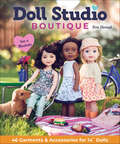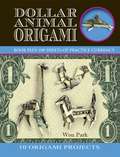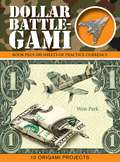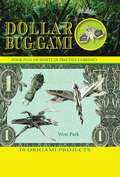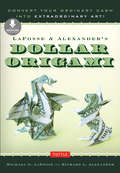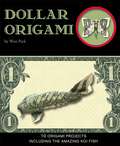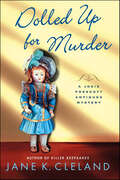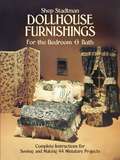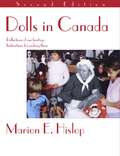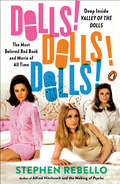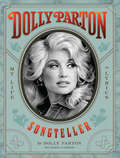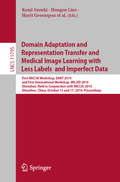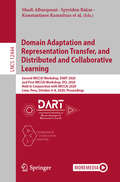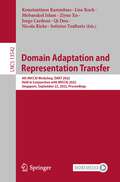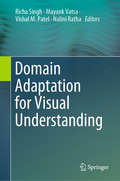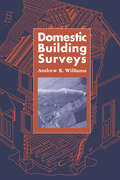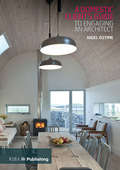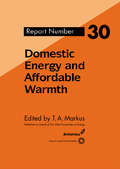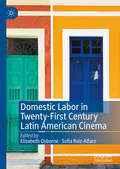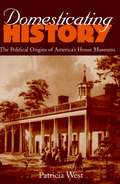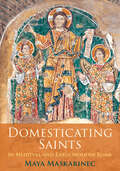- Table View
- List View
Doll Studio Boutique: Sew a Wardrobe; 46 Garments & Accessories for 14" Dolls
by Erin HentzelSew darling dresses, tops, bottoms, and accessories for 14&” dolls with this guide, featuring seven basic garments and forty-six variations. Craft a closet full of the exact looks you love . . . in miniature! Delight the doll lover in your life when you learn to stitch seven basic garments and forty-six variations, sure to inspire for creative play. These simple yet stylish patterns are drafted specifically for 14 ½&” dolls, though most will fit a variety of brands in the 14&” to 15&” range. From vintage party dresses to cozy pajamas, raglan tops, and summer shorts, these tiny garments satisfy each season and special occasion. No matter your skill level, you&’ll love these quick-to-sew garments and more advanced projects, many of which can be made from a single fat quarter. Skirts, tops, totes, dresses, pajamas and more! · Sew sweet separates for the 14&” doll lover in your life · Beginners and proficient sewists can grow their skills while customizing doll attire · Most items can be sewn with a single fat quarter, favorite fabric bits, and trims
Dollar Animal Origami (Origami Books)
by Won ParkAre there barn owls in your billfold?You won't believe all the animals running around in your wallet! Ten new dollar origami models from master paper engineer Won Park will have you bending your banknotes in many new and interesting ways. This kit gives you all the practice currency you need to become adept at creating an array of cash creatures such as dolphins, giraffes, barn owls, lizards, goldfish, Dachshunds, and more! Dive into the step-by-step instruction book and enjoy detailed diagrams and colorful photos to help you perfect each crease and fold. Dollar Animal Origami is a great way to leave an impression with a tip at a restaurant, or just to amaze your friends!
Dollar Battle-Gami (Origami Books)
by Won ParkGot a dollar burning a hole in your pocket? Impress your friends wherever you go with the readily available paper in your wallet. Or leave a creative tip for waiters and bartenders with these creative designs in Dollar Battle-Gami. Master paper engineer Won Park created this sophisticated origami kit for advanced paper artists. These 15 impressive projects turn a dollar bill (or a sheet of the included practice paper) into a combat knife, spy plane, hand grenade, revolver, tank, stealth bomber, stealth fighter, submarine, jet fighter, U.S. Navy destroyer, assault rifle, unmanned aerial drone, sniper rifle, land mine, or a Japanese zero fighter plane. Dollar Battle-Gami offers the next generation of origami enthusiasts a chance to gain a whole new perspective on battle tools and the world of origami.
Dollar Bug-Gami (Origami Books)
by Won ParkIs your wallet bugging out?How many bugs do you have in your wallet? Transform your dollar bills into a collection of insects that will impress everyone! This kit provides everything you need to become an expert origami entomologist. Follow the detailed diagrams in the instruction book and use the practice currency until you can fold up a bug in minutes with your own money. Also, learn about each insect with the field guide information offered at the beginning of each section. Origami critters are a fun, unique way to leave a tip at a restaurant, or to give as a gift!
Dollar Origami
by Richard L. Alexander Michael G. LafosseINVEST IN VALUABLE ORIGAMI ART! These 21 projects range from simple to slightly more challenging-perfect for beginners and more experienced folders. The easy-to-follow full-color instructions make these entertaining designs simple for anyone to create. These delightful money-folding activities are a great way to have fun while waiting for anything, and are a creative and fun way to give a cash gift or tip. Money Origami contains a DVD, 60 practice "dollars" and 64 pages of step-by-step instructions for 21 money-based projects, including: $ Five-Dollar Star $ Dollar BILL Butterfly $ Jumping Frog (with eyes) $ Paper Airplane $ Four-Dollar Tall Box $ And many more!
Dollar Origami
by Richard L. Alexander Michael G. Lafosse$$$ Dollar, dollar bill-create fun and intricate money origami using your Washingtons, Franklins, and Lincolns $$$ These days, a dollar won't get you very far, but-in the right hands-a dollar bill can become a work of art. In Michael LaFosse's Dollar Origami, the world-renowned origami artist and co-founder of the eminent Origamido Studio shares twenty incredible creations specifically designed to be made out of dollar bills. Folded money models are wonderful gifts and conversation pieces, and LaFosse makes it easy for you to get started with projects ranging from "very simple" to "challenging. " This origami book contains: Full color, 64 page book Step-by-step instructions Colorful diagrams and photographs Origami folding guide and tips 20 original origami projects 48 tear-out practice "dollar bills" A 3 hour instructional DVD It's no wonder that more and more people are realizing how fun dollar bill origami can be. Printed currency is easy to fold, remarkably durable, intricately patterned, and readily available. Money origami projects include: The Windmill Pillow Prosperity Bamboo The George Washington Knot Drahcir the Dragon And many more. . .
Dollar Origami: 10 Origami Projects Including the Amazing Koi Fish (Origami Books)
by Won ParkWith Dollar Origami, you'll learn how to fold your dollars into frogs, scorpions, and other creatures and objects.Dollar Origami teaches you how to turn your currency into almost anything with just a few folds. With the help of simple instructions and full-color photos, you'll be crafting beautiful butterflies, adorable penguins, and more in your own home in no time.
Dolled Up for Murder (Josie Prescott Antiques Mysteries)
by Jane K. ClelandCrime-solving antiques dealer Josie Prescott is back—tracking down a doll collection to die for.On a sparkling spring day in the cozy coastal town of Rocky Point, New Hampshire, with the lilacs in full bloom and the wisteria hanging low, antiques dealer Josie Prescott is showing a stellar doll collection she's just acquired to Alice Michaels, the queen of the local investment community. Moments later, Josie watches in horror as Alice is shot and killed. Within hours, one of Josie's employees, Eric, is kidnapped. The kidnapper's ransom demand is simple—he wants the doll collection. Working against the clock with the local police chief, Josie discovers that the dolls hold secrets that will save Eric and uncover the truth behind Alice's murder.With Dolled Up for Murder, Jane K. Cleland's Josie Prescott Anitques Mystery Series "continues to offer clever mysteries studded with enough information on antiques to keep collectors coming back for more." --Publishers Weekly
Dolley Madison Saves George Washington
by Don BrownDolley was a farm girl who became a fine first lady when she married James Madison. She wore beautiful dresses, decorated her home, and threw lavish parties. Everyone talked about Dolley, and everyone loved her, too. Then war arrived at her doorstep, and Dolley had to meet challenges greater than she’d ever known. So Dolley did one thing she thought might make a difference: she saved George Washington. Not the man himself, but a portrait of him, which would surely have been destroyed by English soldiers. Don Brown once again deftly tells a little known story about a woman who made a significant contribution to American history.
Dollhouse Furnishings for the Bedroom and Bath: Complete Instructions for Sewing and Making 44 Miniature Projects
by Shep StadtmanThe museum-quality dollhouse furnishings of noted designer Shep Stadtman have figured prominently in the miniatures industry for many years. Now this accomplished craftswoman shares her experience and expertise with you, showing you how to make your own high-quality furnishings.Dollhouse Furnishings for the Bedroomand Bath offers miniature enthusiasts easy-to-follow instructions in the techniques of woodworking and sewing for small projects — plus clear step-by-step directions, patterns, and diagrams for 44 exquisite miniature projects in styles ranging from country to contemporary. Learn to make beds, bedding, quilts, pillows, night stands, draperies, shower curtains, covered headboards, braided rugs, towels, and much more.In addition, you'll find directions for creating five complete bedroom ensembles and two complete bathrooms — each with a distinctive décor of its own.No dollhouse is truly complete without a properly embellished suite of bedrooms and a tastefully appointed bath. Dollhouse enthusiasts will find in this marvelous book all the information they need to turn a miniature house into a breathtaking showpiece.
Dolls In Canada
by Marion E. HislopDolls in Canada is two books in one. The first section is a personal and engaging look at dolls which make up our heritage; pioneer dolls, native people’s dolls, dolls from various cultural groups in Canada, dolls from legends and stories, dolls in different styles and materials, and dolls by Canadian artists. Part two contains easy-to-follow instructions on how to make over fifteen different types of dolls, from rag dolls to jumping jacks, from hanky panky dolls to clothespeg dolls.
Dolls! Dolls! Dolls!: Deep Inside Valley of the Dolls, the Most Beloved Bad Book and Movie of All Time
by Stephen Rebello"A blissful treasure trove of gossipy insider details that Dolls fans will swiftly devour."--Kirkus ReviewsThe unbelievable-but-true, inside story of Jacqueline Susann's pop culture icon Valley of the Dolls--the landmark novel and publishing phenomenon, the infamous smash hit film ("the best worst movie ever made"), and Dolls's thriving legacy todaySince its publication in 1966, Jacqueline Susann's Valley of the Dolls has reigned as one of the most influential and beloved pieces of commercial fiction. Selling over thirty-one million copies worldwide, it revolutionized overnight the way books got sold, thanks to the tireless and canny self-promoting Susann. It also generated endless speculation about the author's real-life models for its larger-than-life characters. Turned in 1967 into an international box-office sensation and morphing into a much-beloved cult film, its influence endures today in everything from films and TV shows to fashion and cosmetics tributes and tie-ins. Susann's compulsive readable exposé of three female friends finding success in New York City and Hollywood was a scandalous eye-opener for its candid treatment of sex, naked ambition, ageism, and pill-popping, and the big screen version was one of the most-seen and talked-about movies of the time.Dolls! Dolls! Dolls! digs deep into the creation of that hugely successful film--a journey nearly as cut-throat, sexually-charged, tragic, and revelatory as Susann's novel itself--and uncovers how the movie has become a cherished, widely imitated camp classic, thanks to its over-the-top performances, endlessly quotable absurd dialogue, outré costumes and hairdos, despite the high aspirations, money, and talent lavished on it. Screenwriter-journalist-film historian Stephen Rebello has conducted archival research and new interviews to draw back the velvet curtain on the behind-the-scenes intrigue, feuds and machinations that marked the film's production. In doing so, he unveils a rich, detailed history of fast-changing, late 1960s Hollywood, on screen and off.
Dolly Parton, Songteller: My Life in Lyrics
by Robert K. Oermann Dolly PartonDolly Parton, Songteller: My Life in Lyrics is a landmark celebration of the remarkable life and career of a country music and pop culture legend.As told by Dolly Parton in her own inimitable words, explore the songs that have defined her journey. Illustrated throughout with previously unpublished images from Dolly Parton's personal and business archives.Mining over 60 years of songwriting, Dolly Parton highlights 175 of her songs and brings readers behind the lyrics.• Packed with never-before-seen photographs and classic memorabilia• Explores personal stories, candid insights, and myriad memories behind the songsDolly Parton, Songteller: My Life in Lyrics reveals the stories and memories that have made Dolly a beloved icon across generations, genders, and social and international boundaries. Containing rare photos and memorabilia from Parton's archives, this book is a show-stopping must-have for every Dolly Parton fan.• Learn the history behind classic Parton songs like "Jolene," "9 to 5," "I Will Always Love You," and more.• The perfect gift for Dolly Parton fans (everyone loves Dolly!) as well as lovers of music history and countryAdd it to the shelf with books like Coat of Many Colors by Dolly Parton, The Beatles Anthology by The Beatles, and Born to Run by Bruce Springsteen.
Dolor y gloria
by Pedro AlmodóvarLa película más personal de Pedro Almodóvar. El libro más repleto de extras. Salvador Mallo es un veterano director de cine aquejado de múltiples dolencias, pero el peor de sus males es la incapacidad para seguir rodando. La mezcla de medicamentos y drogas hace que Salvador pase la mayor parte del día postrado. Este estado de duermevela le traslada a una época de su vida que nunca visitó como narrador: su infancia en los años sesenta, cuando emigró con sus padres a un pueblo de Valencia en busca de prosperidad. También se le vuelve a aparecer su primer amor adulto, ya en el Madrid de los ochenta, y el dolor que supuso la ruptura. Salvador se refugia en la escritura como única terapia para olvidar lo inolvidable. Ese ejercicio lo devuelve al temprano descubrimiento del cine, cuando las películas se proyectaban sobre un muro encalado, al aire libre, con olor a pis, a jazmín y a brisa de verano. De nuevo, descubrirá que el cine puede ser su única salvación frente al dolor, la ausencia y el vacío. Esta edición contiene, además del guion original de la película (que incluye escenas que no se vieron en el cine), un sustancioso apartado de comentarios sobre su proceso creativo y el rodaje, firmado por el propio Almodóvar, y un precioso epílogo de Gustavo Martín Garzo. Además, está profusamente ilustrada a todo color con fotografías y fragmentos del storyboard. Un libro perfecto para todos los amantes del cine y la cultura.
Domain Adaptation and Representation Transfer and Medical Image Learning with Less Labels and Imperfect Data: First MICCAI Workshop, DART 2019, and First International Workshop, MIL3ID 2019, Shenzhen, Held in Conjunction with MICCAI 2019, Shenzhen, China, October 13 and 17, 2019, Proceedings (Lecture Notes in Computer Science #11795)
by Qian Wang M. Jorge Cardoso Shadi Albarqouni Steve Jiang Fausto Milletari Hien V. Nguyen Nicola Rieke Ziyue Xu Konstantinos Kamnitsas Vishal Patel Badri Roysam Kevin Zhou Khoa Luu Ngan LeThis book constitutes the refereed proceedings of the First MICCAI Workshop on Domain Adaptation and Representation Transfer, DART 2019, and the First International Workshop on Medical Image Learning with Less Labels and Imperfect Data, MIL3ID 2019, held in conjunction with MICCAI 2019, in Shenzhen, China, in October 2019. DART 2019 accepted 12 papers for publication out of 18 submissions. The papers deal with methodological advancements and ideas that can improve the applicability of machine learning and deep learning approaches to clinical settings by making them robust and consistent across different domains. MIL3ID accepted 16 papers out of 43 submissions for publication, dealing with best practices in medical image learning with label scarcity and data imperfection.
Domain Adaptation and Representation Transfer, and Affordable Healthcare and AI for Resource Diverse Global Health: Third MICCAI Workshop, DART 2021, and First MICCAI Workshop, FAIR 2021, Held in Conjunction with MICCAI 2021, Strasbourg, France, September 27 and October 1, 2021, Proceedings (Lecture Notes in Computer Science #12968)
by M. Jorge Cardoso Shadi Albarqouni Islem Rekik Nicola Rieke Ziyue Xu Konstantinos Kamnitsas Daguang Xu Qi Dou Bishesh Khanal Debdoot Sheet Sotirios TsaftarisThis book constitutes the refereed proceedings of the Third MICCAI Workshop on Domain Adaptation and Representation Transfer, DART 2021, and the First MICCAI Workshop on Affordable Healthcare and AI for Resource Diverse Global Health, FAIR 2021, held in conjunction with MICCAI 2021, in September/October 2021. The workshops were planned to take place in Strasbourg, France, but were held virtually due to the COVID-19 pandemic.DART 2021 accepted 13 papers from the 21 submissions received. The workshop aims at creating a discussion forum to compare, evaluate, and discuss methodological advancements and ideas that can improve the applicability of machine learning (ML)/deep learning (DL) approaches to clinical setting by making them robust and consistent across different domains. For FAIR 2021, 10 papers from 17 submissions were accepted for publication. They focus on Image-to-Image Translation particularly for low-dose or low-resolution settings; Model Compactness and Compression; Domain Adaptation and Transfer Learning; Active, Continual and Meta-Learning.
Domain Adaptation and Representation Transfer, and Distributed and Collaborative Learning: Second MICCAI Workshop, DART 2020, and First MICCAI Workshop, DCL 2020, Held in Conjunction with MICCAI 2020, Lima, Peru, October 4–8, 2020, Proceedings (Lecture Notes in Computer Science #12444)
by M. Jorge Cardoso Shadi Albarqouni Spyridon Bakas Bennett Landman Fausto Milletari Nicola Rieke Ziyue Xu Konstantinos Kamnitsas Wenqi Li Holger Roth Daguang XuThis book constitutes the refereed proceedings of the Second MICCAI Workshop on Domain Adaptation and Representation Transfer, DART 2020, and the First MICCAI Workshop on Distributed and Collaborative Learning, DCL 2020, held in conjunction with MICCAI 2020 in October 2020. The conference was planned to take place in Lima, Peru, but changed to an online format due to the Coronavirus pandemic. For DART 2020, 12 full papers were accepted from 18 submissions. They deal with methodological advancements and ideas that can improve the applicability of machine learning (ML)/deep learning (DL) approaches to clinical settings by making them robust and consistent across different domains.For DCL 2020, the 8 papers included in this book were accepted from a total of 12 submissions. They focus on the comparison, evaluation and discussion of methodological advancement and practical ideas about machine learning applied to problems where data cannot be stored in centralized databases; where information privacy is a priority; where it is necessary to deliver strong guarantees on the amount and nature of private information that may be revealed by the model as a result of training; and where it's necessary to orchestrate, manage and direct clusters of nodes participating in the same learning task.
Domain Adaptation and Representation Transfer: 4th MICCAI Workshop, DART 2022, Held in Conjunction with MICCAI 2022, Singapore, September 22, 2022, Proceedings (Lecture Notes in Computer Science #13542)
by Jorge Cardoso Nicola Rieke Ziyue Xu Konstantinos Kamnitsas Lisa Koch Qi Dou Sotirios Tsaftaris Mobarakol IslamThis book constitutes the refereed proceedings of the 4th MICCAI Workshop on Domain Adaptation and Representation Transfer, DART 2022, held in conjunction with MICCAI 2022, in September 2022. DART 2022 accepted 13 papers from the 25 submissions received. The workshop aims at creating a discussion forum to compare, evaluate, and discuss methodological advancements and ideas that can improve the applicability of machine learning (ML)/deep learning (DL) approaches to clinical setting by making them robust and consistent across different domains.
Domain Adaptation for Visual Understanding
by Vishal M. Patel Richa Singh Mayank Vatsa Nalini RathaThis unique volume reviews the latest advances in domain adaptation in the training of machine learning algorithms for visual understanding, offering valuable insights from an international selection of experts in the field. The text presents a diverse selection of novel techniques, covering applications of object recognition, face recognition, and action and event recognition.Topics and features: reviews the domain adaptation-based machine learning algorithms available for visual understanding, and provides a deep metric learning approach; introduces a novel unsupervised method for image-to-image translation, and a video segment retrieval model that utilizes ensemble learning; proposes a unique way to determine which dataset is most useful in the base training, in order to improve the transferability of deep neural networks; describes a quantitative method for estimating the discrepancy between the source and target data to enhance image classification performance; presents a technique for multi-modal fusion that enhances facial action recognition, and a framework for intuition learning in domain adaptation; examines an original interpolation-based approach to address the issue of tracking model degradation in correlation filter-based methods.This authoritative work will serve as an invaluable reference for researchers and practitioners interested in machine learning-based visual recognition and understanding.
Domestic Building Surveys
by Andrew WilliamsThis is a practical guide showing how to undertake a domestic building survey. The text describes the practical aspects of surveying with a full description of the author's own experience, at the same time drawing out the important principles involved.
Domestic Client's Guide to Engaging an Architect: To Engaging An Architect
by Nigel OstimeIf you need to understand about engaging the services of an architect, this updated RIBA guide is for you. Straightforward and completely up-to-date regarding legislation, it sets out everything you need to be aware of, for a large or small domestic project. The right architect can bring considerable added value to the success of your project. This guide talks you through all aspects of your project and what you should expect from your architect at each stage - including formal appointment mechanisms, calculating fees and project management responsibilities. For domestic clients, both for large or small projects, and especially those who have never carried out this role before, this guide offers a quick and easy overview of the value, mechanisms and context of appointing your architect.
Domestic Energy and Affordable Warmth (The\watt Committee On Energy Ser. #Vol. 30)
by T. MarkusThis report arises out of the Working Group set up by The Watt Committee on Energy to examine the issues relating to domestic use and affordable warmth. With contributions from both academia and industry, and also calling on the expertise of others deeply involved in the subject, this book provides the reader with an authoritative coverage of providing affordable warmth to those living on low means or in inadequate premises.
Domestic Labor in Twenty-First Century Latin American Cinema
by Elizabeth Osborne Sofía Ruiz-AlfaroThis volume explores the character of the domestic worker in twenty-first century Latin American cinema and analyzes how recent filmic representations of the housemaid question the marginalization of domestic servants, in particular women, by making them the center of their narratives, their families, and society. The essays in this book posit the female domestic worker as an emergent subjectivity, a complex character who problematizes and contests the hierarchical power structures within the family dynamics and new socioeconomic orders found in contemporary Latin America. Readers will find a variety of representations across the continent as well as transnational commonalities of the cinematic figure and role of the housemaid, including the negotiation of a multilayered politics of affection in the framework of prevalent paternalism, and the complex and contradictory dynamic between private and public spaces, where domestic paid labor occupies a central role in maintaining gender, class, and ethnic inequalities.
Domesticating History: The Political Origins of America's House Museums
by Patricia WestCelebrating the lives of famous men and women, historic house museums showcase restored rooms and period furnishings, and portray in detail their former occupants' daily lives. But behind the gilded molding and curtain brocade lie the largely unknown, politically charged stories of how the homes were first established as museums. Focusing on George Washington's Mount Vernon, Louisa May Alcott's Orchard House, Thomas Jefferson's Monticello, and the Booker T. Washington National Monument, Patricia West shows how historic houses reflect less the lives and times of their famous inhabitants than the political pressures of the eras during which they were transformed into museums.
Domesticating Saints in Medieval and Early Modern Rome (The Middle Ages Series)
by Maya MaskarinecHow elite Roman families used genealogy, architecture, and the urban fabric to appropriate the city’s saints for their ownDomesticating Saints in Medieval and Early Modern Rome explores the creative efforts of some of Rome’s most prominent noble families to weave themselves into Rome’s Christian past. Maya Maskarinec shows how, from late antiquity to early modernity, elite Roman families used genealogy, architecture, and the urban fabric to appropriate the city’s saints for their own, eventually claiming them as ancestors.Over the course of the Middle Ages, there developed a pronounced sense that churches and their saints belonged to specific regions, neighborhoods, and even families. These associations, coupled with a resurgent interest in Rome’s Christian antiquity as well as in noble lineages, enabled Roman families to “domesticate” the city’s saints and dominate the urban landscape and its politics into the early modern era. These families cultivated saintly genealogies and saintly topologies (exploiting, for example, the increasingly prolific identification of churches as the former residences of early Christian and late antique saints), cementing presumed connections between place, descent, and moral worth.Drawing from sources spanning the fourth to the late sixteenth century, Maskarinec brings into conversation saints’ lives, documentary evidence, family genealogies, monumental and domestic architecture, and medieval and early modern guidebooks, sources not often studied together. Bridging the divide between secular and sacred histories of Rome, Domesticating Saints in Medieval and Early Modern Rome repositions these materials within a new story, of how Romans made the city’s classical and Christian past their own and thereby empowered and immortalized their families.
